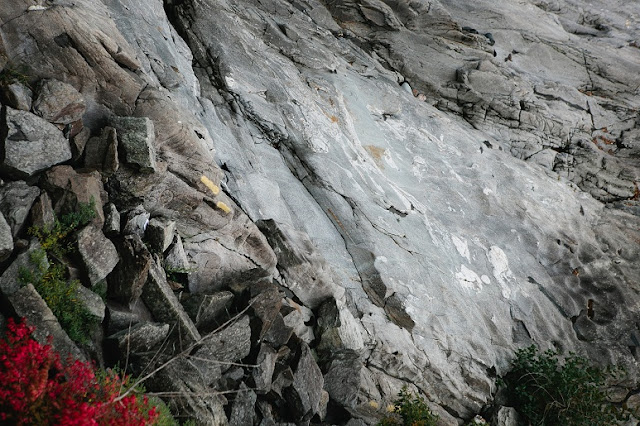November 6, 2012 — I can do this post in one sentence: Rudimentary faces believed to be of Native American origin are carved into granite boulders on the side of a river in Vermont. Now, I’ll do the 800-word version, just to show you what a big scam writing is.
Actually, this is one of my favorite types of posts to write. Simple to describe (see above) and simple to research since pretty much nothing is known about the topic.
The Bellows Falls Petroglyphs (a petroglyph is an image carved into rock) are located on a pair of large, loose boulders on the side of the Connecticut River in Bellows Falls, Vermont. The river is the boundary between that town and Walpole, New Hampshire, so the engravings are the thin width of a river away from being called the Walpole Petroglyphs. I’d like to believe this is a point of contention between the two towns, but they probably get along fine at the local high school basketball games.
The petroglyphs depict two groupings of what appear to be twenty-odd face-sized faces clustered together like they’re in one of those crowd scenes that inspired Ezra Pound to bum us commuters out about our lives. At least, everybody seems to agree that they depict a bunch of faces, even if there is disagreement about whether those faces are human, animal, or other. To be literal, though, they’re an arrangement of rough circles, each enclosing three dots, and some of which have pairs of lines radiating from their tops.
We do know that these petroglyphs date back to at least 1789, when a preacher from Dartmouth College named David McClure wrote about them while visiting the area. They’re believed to have been carved by the Abenaki, since those were the native natives back then.
We also know that they’ve been messed with over the years, although to what extent is up for debate. For instance, McClure’s original description included only three faces, leading some to postulate that the carvings have been added to since then. In addition, his drawings of the petroglyphs revealed faces that were slightly more detailed than what exist today, although still simplistic…think Bunsen Honeydew minus the glasses.
 |
| From Picture Rocks: American Indian Rock Art in the Northeast Woodlands by Edward J. Lenik |
In the 1930s, locals had the carvings deepened in a misguided attempt to preserve them from the constant erosion of the river, thereby damaging the value of the images as historical artifacts but not really our chances at learning more about them.
 |
| Red circles indicate the two groupings of petroglyphs...and the limits of my artistic ability. |
Actually, the lines atop the circles really are the most interesting part of the carvings. Besides alien antennae and demon horns, they’ve also been described as feathers from headdresses, antlers from deer, pre-brush-era hair, and somebody doing donkey ears in the primitive equivalent of a class picture. One of those is my contribution to the field.
I saw these guys a little over a month ago (there’s some brief footage in the Veering to Vermont video I put together from that trek). They definitely struck me as faces, but I also got the weird impression that they were a choir of some sort, singing with O-mouths like the kids in A Charlie Brown’s Christmas.
To see them for yourself, just drive to the Vermont side of the Vilas Bridge, at the eastern end of Bridge Street (the western end also crosses a bridge, but that one’s in the center of Bellows Falls, and you want to be on the edge of the town). There you’ll see a sign pointing toward the “Indian Carvings.” Walk just a few steps onto the bridge to the far side from the sign and direct your gaze almost straight down at the rocky shore.
While I was there, four short lines of yellow paint marked the location of the petroglyphs, and traces of yellow paint were still evident from a previous tracing of the engravings themselves.
They’re not too hard to make out from that height, but it definitely improves the situation to use binoculars, a zoom lens, or Inspector Gadget’s neck. You could probably scrabble down to them for a closer look if you wanted to as well, but according to a warning sign posted at the spot, the river floods regularly. And I’m not just talking during a hard rain. The flow is artificially controlled by a nearby damn, meaning the banks can be submerged at any point according to the whims of whoever’s shift it is at the water works.
Of course, that just makes me wonder what that Peanuts gang rendition of O Christmas Tree sounds like underwater.
All because some Native American guys were having a slow fishing day.






